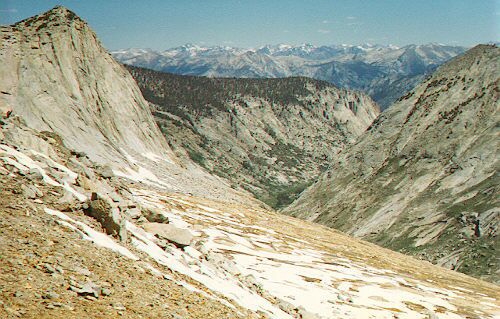
Deadman Canyon Loop

The view from the pass looking down into Deadman Canyon.
Elizabeth Pass, 11,380 Feet!
Deadman Canyon Loop - By D.W.Donehoo (All rights reserved)
Eventually you must leave this Sierra paradise and it is strongly advised you get a very early start for your 2100 foot assent to Elizabeth Pass at 11,380 feet. With plenty of time the early start affords, you can take a moderate or leisurely pace and be assured you will crest the pass before the second most dangerous elemental force in the backcountry, an
afternoon thunder and lightening storm, can form and threaten. Also, if there is plenty of snow visible from camp and early start will assure fairly firm footing on the snow. Normally, you should always wear sunblock to protect you from UV rays, but this day requires special attention to this task: don't forget to protect your nose and nostrils, under the chin, ears, or any exposed skin. Sun glare off snow also requires that you at least wear sunglasses, or better yet glacier glasses. Most of the year this pass has a particularly large snow field and you should be prepared for the possibility of a long walk over snow. Wearing gaiters is also encouraged: even if there is not that much snow, at least they will keep the rocks and snow out of your boots.
The waterfall at the very head of Deadman Canyon. The trail crosses the falls at the top over large rocks.
Summiting a pass is THE primary activity of the serious backpacker. On the John Muir Trail or the Pacific Crest Trail, and most all major trails and routes, it seems that every day you spend half your day climbing towards a pass and the other half descending from a pass. It is the hardest sweat drenched lung heaving work you have to do, but it has the biggest payoff for all your toils and pains. You have been on the trail for a few days now and your are now stronger than when you started and ready to take on a real Sierra high country pass. Leaving camp bright and early, the tread is level for nearly two miles of this last "giant step": it just does not look to be that far to the end of the canyon, or that it should take so long to get there. The trail is faint in places and eventually it begins to switchback up the left southeastern side of the canyon end to top out at a little flat bench the waterfall you have been admiring leaps from. This is a good spot for a short rest and to put on your sunblock and other gear, if you have not done so already. The view down the canyon is great and you can admire the deceptive length of this portion of the canyon. After carefully crossing the waterfall stream, pick up the trail and follow it as long as you can. The trail gets dramatically steeper and in early season may disappear underneath the
snow or just fade away in places. If there is alot of snow cover, you may be able to follow the snowy footsteps of others who have ascended to or descended from the pass. If you are lucky enough to be the first, merely head southeast and look for the saddle between two minor peaklets. The pass itself is bound to be snow free even in early season, but there are no guarantees. Make sure you have brought a compass and a good map, preferable a 7.5 Minute Triple Divide Peak Quadrangle topo map and have it handy. As you near the pass, the cirque bowl flattens out somewhat although you never stop climbing.
As you frequently pause to catch your breath, look to the southeast rim of the headwall and you may be able to make out a trail, possibly through the snow, to an old copper mine. The miners who worked the claim camped at the head of Cloud Canyon, and accessed the mine via a small pass in the headwall to the southwest of their camp. History indicates the miners spent more time fishing, hunting and generally vacationing than working their claim. Who could blame them considering their surroundings. The mine still gets the occasional backcountry visitor.
The view back down the canyon from the top of the falls.
When you finally get to the pass, you may have to slog up some steep snow to get to the top, but most likely you will reach the end of the snow and find yourself on actual trail that takes you the last few feet to the top. It only took me a few minutes to put into words what takes what seemed at the time like an eternity of slogging uphill in too little thin air to reach the pass. It takes no special talents to reach the pass other than to keep putting one foot in front of the other until you get there.